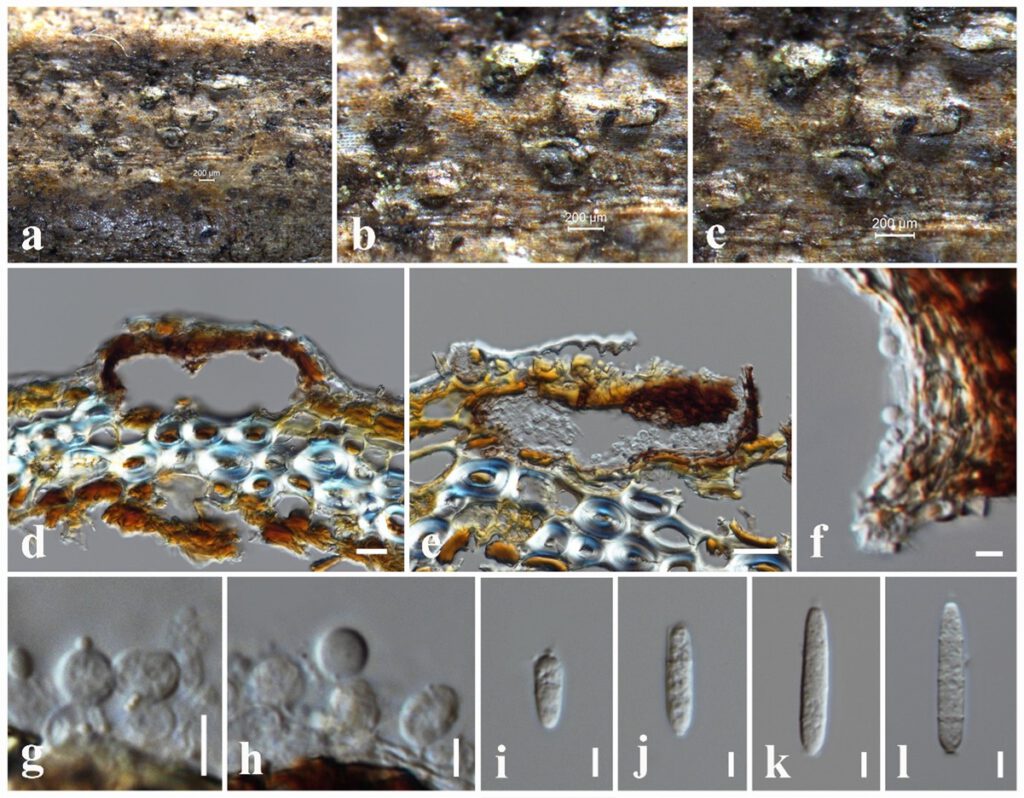Acrocalymma magnoliae N.I. de Silva, Lumyong & K.D. Hyde, sp. nov.
MycoBank number: MB 559515; Index Fungorum number: IF 559515; Facesoffungi number: FoF 10713; Fig. 6.6
Etymology: Name reflects the host genus Magnolia, from which the new species was isolated.
Holotype: MFLU 18-1306
Saprobic on dead twigs attached to Magnolia liliifera. Sexual morph: Undetermined. Asexual morph: Coelomycetous. Conidiomata 135–160 × 200–230 µm ( = 145 × 215 μm, n = 10), sub-globose, dark brown or black, semi-immersed to erumpent, solitary, scattered without ostiole. Conidiomatal wall 20–35 μm wide, composed of several layers of small, flattened, brown to dark brown pseudoparenchymatous cells, cells towards the inside lightly pigmented, arranged in a textura angularis, at the outside, darker, fusing and indistinguishable from the host tissues. Conidiophores reduced to conidiogenous cells. Conidiogenous cells 7–12 × 3–7 µm ( = 10 × 5 μm, n = 10), phialidic, hyaline, smooth, ampulliform to doliiform, proliferating with visible periclinal thickening at apex. Conidia 22–30 × 5–7 μm ( = 26 × 6 μm, n = 40), hyaline, smooth, guttulate, thin-walled, straight, cylindrical to fusoid, apex obtuse, unicellular, 2–3 pseudosepta present with flaring mucoid. Apical appendage at lower end, visible in water mounts.
Culture characteristics – Colonies on PDA reaching 20 mm diameter after 1 weeks at 25°C, colonies from above: circular, margin entire, dense, slightly raised, cottony to fairy fluffy appearance, white at the margin, olivaceous green in the centre; reverse: cream at the margin, greyish green in the centre.
Material examined – THAILAND, Chiang Mai Province, dead twigs attached Magnolia garrettii (Magnoliaceae), 15 November 2017, N. I. de Silva, NI209 (MFLU 18-1306, holotype), living culture, MFLUCC 18-0545, THAILAND, Chiang Rai Province, dead twigs attached to host plant of Anomianthus dulcis (Annonaceae), 4 April 2019, N. I. de Silva, AND31 (MFLU 21-0206), living culture, MFLUCC 21-0204.
Notes – The morphology of our collection (MFLU 18-1306 and MFLU 21-0206) tally with it being an Acrocalymma species in having globose, semi-immersed to immersed, ostiolate conidiomata, ampulliform to doliiform, hyaline conidiogenous cells and hyaline, smooth, guttulate, cylindrical to fusoid, unicellular conidia (Trakunyingcharoen et al. 2014, Jayasiri et al. 2019, tennakoon et al. 2021). Multi-gene phylogeny indicates that our collection is nested independently, as sister to the clade containing Acrocalymma bipolare, A. medicaginis, A. pterocarpi with 99% ML, 0.99 BYPP support. It is interesting to note that this is the first Acrocalymma species record from Magnolia garrettii and Anomianthus dulcis.

Figure 6.6 Acrocalymma magnoliae (MFLU 18-1306, holotype) a–c Appearance of immersed conidiomata on substrate. d, e Vertical sections through conidiomata. f Conidiomatal wall. g, h Conidiogenous cells. i–l Conidia. Scale bars: a–c = 200 μm, d, e = 20 μm, f–l = 5 μm.
